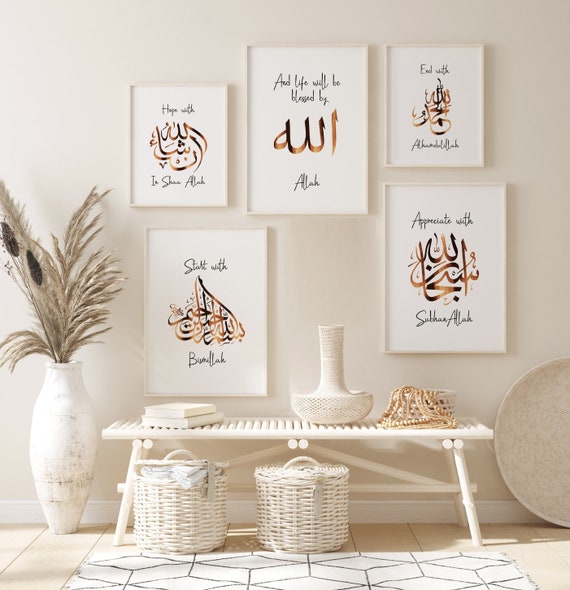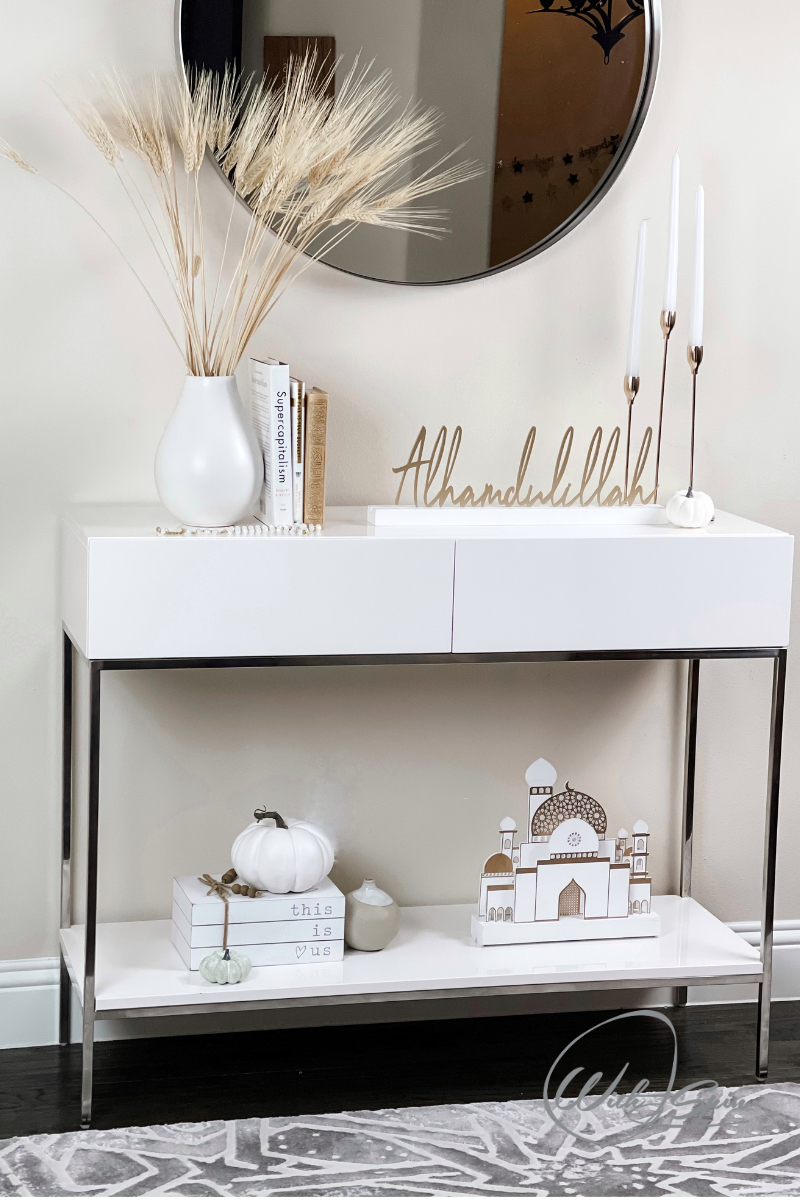If you’re looking to infuse your home with beauty, serenity, and cultural significance, Muslim home decor offers a rich tapestry of design elements that reflect Islamic values and aesthetics. In this comprehensive guide, I will delve deep into the various styles, elements, and practical tips for creating a harmonious and inviting Muslim home. Drawing from personal experience and insights from the community, we’ll explore how to make your living space truly reflective of your faith and love for beauty.
Understanding the Essence of Muslim Home Decor
Before we dive into the specifics, it’s essential to understand what Muslim home decor entails. It encompasses a range of styles and elements inspired by Islamic traditions, art, and culture. From intricate geometric patterns to the calming ambiance created by natural materials, these design elements can transform any space into a sanctuary of peace.
Key Elements of Muslim Home Decor
- Calligraphy: Arabic calligraphy often features prominently, embodying verses from the Quran or sayings from the Prophet Muhammad (PBUH).
- Geometric Patterns: Islamic art is renowned for its intricate geometric designs that symbolize the infinite nature of Allah.
- Natural Materials: Wood, stone, and textiles not only add warmth but also connect us to the natural world.
- Color Palette: Earthy tones combined with vibrant accents create a soothing and inviting atmosphere.

Choosing the Right Colors for Your Muslim Home
Creating a Harmonious Color Scheme

Color plays a vital role in setting the mood of your home. For Muslim decor, consider using a palette that reflects tranquility. Here’s a breakdown of popular colors and their meanings:
| Color | Meaning |
|---|---|
| Blue | Peace and tranquility |
| Green | Life and growth; associated with paradise |
| White | Purity and peace |
| Earthy Tones | Connection to nature and grounding |

Tips for Incorporating Color in Your Space
- Use accent walls to highlight beautiful calligraphy or art pieces.
- Incorporate throw pillows and rugs in soft tones to add warmth.
- Balance bold colors with neutral backgrounds to avoid overwhelming the senses.

Incorporating Islamic Art and Calligraphy
Enhancing Your Home with Art

Islamic art is not just decorative; it’s a medium of expression reflecting faith and values. Here are some ways to incorporate art into your home:
- Framed Calligraphy: Invest in beautiful framed pieces featuring Quranic verses or religious quotes.
- Mosaics and Tiles: Use tiles with intricate designs in kitchens and bathrooms to add authentic flair.
- Canvas Prints: Modern prints of Islamic art can be a stylish update for contemporary spaces.

Personal Experience with Islamic Art
When I first started decorating my home, I found that adding pieces of Islamic art didn’t just beautify my space; it brought a sense of calm and purpose. Watching the light play off a well-placed calligraphy piece transformed my living room into a reflection of my faith and values.

Furniture Choices for a Muslim Home
Traditional Versus Modern Muslim Decor
When selecting furniture, consider the balance between traditional and contemporary styles. Here’s a quick comparison:
| Traditional | Modern |
|---|---|
| Intricately carved wooden pieces | Sleek, minimalist designs |
| Rich fabrics and patterns | Neutral colors with subtle textures |
| Low seating arrangements (diwan) | Standard height with a focus on functionality |
Choosing Functional and Stylish Furniture
Here are some pros and cons to consider when choosing furniture:
Pros of Traditional Furniture
- Uniqueness and character
- Rich cultural significance
- Often handcrafted
Cons of Traditional Furniture
- May require more maintenance
- Can be bulky and less versatile
Pros of Modern Furniture
- Space-saving designs
- Easy to maintain
- Versatile and functional
Cons of Modern Furniture
- Less emotional connection
- May not reflect cultural heritage
Textiles and Fabrics in Muslim Decor
Choosing the Right Textiles
Textiles play a crucial role in adding warmth and comfort to your home. Consider the following:
- Curtains: Opt for light, flowing fabrics that allow natural light while providing privacy.
- Rugs: Persian or Turkish rugs can be stunning focal points that evoke a sense of comfort.
- Throws and Pillows: Use cushions in rich colors to add layers and coziness to your seating areas.
Creating a Prayer Space at Home
Designing a Dedicated Area for Worship
Having a designated prayer area is essential for maintaining your spiritual practice. Here are some key features to consider:
- Cleanliness: Ensure the area is tidy and free from distractions.
- Orientation: Position the prayer mat towards the Qibla (the direction of the Kaaba in Mecca).
- Comfort: Add soft rugs and cushions to create a welcoming and comfortable space for prayer.
Personal Insights on Creating a Prayer Space
Setting up my prayer space was an emotional journey. Incorporating soft lighting and my favorite Islamic art pieces made it a sanctuary that resonates with peace and reflection. It has become my go-to place for solitude and connection with Allah.
Incorporating Plants and Nature into Your Home Decor
The Benefits of Greenery
Bringing plants into your home not only enhances its aesthetic appeal but also promotes a sense of calm. Here are some plants that can beautifully complement Muslim decor:
- Palm Trees: Symbolizing paradise in many cultures.
- Scented Herbs: Such as rosemary and mint, for a refreshing atmosphere.
- Cacti and Succulents: Low-maintenance options that add a modern touch.
Creating a Natural Ambiance
Integrating plants into your decor can create a natural ambiance that reflects the beauty of Allah’s creations.
Lighting Ideas for a Serene Atmosphere
Types of Lighting to Consider
Lighting dramatically influences the atmosphere of your home. Here are some ideas for effective lighting:
- Lanterns: Use traditional lanterns for soft, warm lighting; they can be both decorative and functional.
- Candlelight: Incorporate candles for a serene and romantic ambiance.
- Modern Fixtures: Choose contemporary light fixtures that reflect your personal style while providing adequate illumination.
DIY Muslim Home Decor Ideas
Crafting Your Own Decor
Creating your decor can be a fulfilling and personal experience. Here are a few DIY projects to enhance your home:
- Hand-Painted Calligraphy: Create your own art by painting favorite verses on canvas.
- Decorative Pillows: Sew or decorate plain pillows with geometric patterns.
- Customized Wall Hangings: Use wood or fabric to create unique wall art that reflects your personality and faith.
Maintaining a Muslim-Inspired Home
Keeping Your Space Clean and Serene
Maintaining a harmonious environment is crucial for a Muslim home. Here are some tips:
- Establish a cleaning routine to keep the space clutter-free and organized.
- Incorporate calming scents, such as essential oils, to create a soothing atmosphere.
- Regularly rearrange or refresh decor to keep the space vibrant and alive.
FAQs About Muslim Home Decor
What are some popular design styles in Muslim home decor?
Popular styles include traditional Islamic, contemporary, and fusion designs that combine Islamic elements with modern aesthetics.
How can I incorporate Islamic values into my home decor?
By using art, calligraphy, and natural elements that reflect your faith and values, you can create a home that honors Islamic traditions.
Can I mix modern decor with traditional Muslim elements?
Yes! Mixing styles can create a unique and personal aesthetic. The key is to maintain harmony and balance in your design choices.
What materials are best for Muslim home decor?
Natural materials such as wood, stone, and textiles are preferred for their warm, inviting feel, while also being environmentally friendly.
Conclusion: Creating Your Dream Muslim Home
Decorating your home with Muslim decor is not just about aesthetics; it’s an opportunity to create a space that resonates with peace, spirituality, and your personal faith journey. By incorporating the elements we’ve discussed, you can design an environment that reflects your values, nurtures your spirit, and enhances your everyday living experience. Embrace your creativity, enjoy the process, and let your home be a sanctuary of serenity.